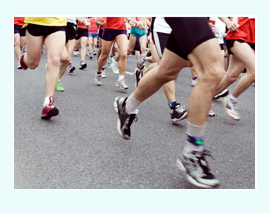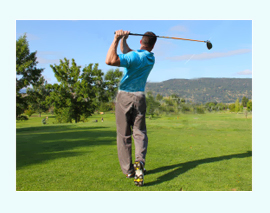Biomechanical Assessment
Biomechanics is the science concerned with the internal and external forces acting on the human body and the effects produced by these forces. It is concerned with the preservation, restoration and development of the function of the foot. At each step, the normal foot will flatten the arch (pronate) to absorb shock, become a stable platform, and then after the correct time interval heighten the arch (supinate) to propel into the next step. Individuals who excessively pronate or supinate may suffer a number of problems. These stresses are magnified in an athlete or sportsperson.
Poor biomechanical function of the foot and leg can cause related foot, knee and back problems. These related problems can be treated effectively through the use of orthoses.
Typical conditions for treatment include:
- Ankle instability/recurrent sprains
- Knee/hip pain
- Lower back pain
- Shin splints/Tired aching legs
- Heel pain/plantar fasciitis
- Achilles pain (Achilles tendonitis)
- Outside knee and hip pain (ilio-tibial band syndrome)
- Hallux abducto valgus (deviation of the 1st toe joint and bunion)
- Bunions
- Burning pain in the forefoot (metatarsalgia)
- Osteo arthritis in foot and knee.
During your consultation, your walking is observed, the range of motion within your joints measured, muscle symmetry and strength assessed and finally the compensatory mechanisms occurring within the foot and leg. Your practitioner will discuss with you the most suitable treatment to optimise normal foot and leg function. These treatments may include exercise programmes and the use of orthoses (inserts for your shoes).
Orthoses
An orthosis is a medical term which describes a device that supports, realigns or assists in the function of the musculo-skeletal system. In podiatry we use foot orthoses to support, align or improve the function of the feet and lower limbs during gait. Functional orthoses apply forces to the feet enabling the podiatrist to alter certain movements or off-load stress within tissues. Non-functional orthoses (insoles) may be designed to improve skin and tissue viability or off-load painful pressure areas.
Sports Injuries
Many sports involve repetitive action of joints and muscle groups in the lower leg and foot. Running can increase the pressure on the foot by three or four times body weight, thus overuse injuries are a common result. – If you have repeated lower limb injury , it is likely to be caused by a mechanical problem or imbalance in the body. To relieve the symptoms, the cause of the imbalance must be identified and treated accordingly.
Podiatric intervention supports recovery of both chronic and acute injury. Biomechanical assessment and orthoses optimises biomechanical stability and thus reduces stress on the lower limb. Acute injury benefits from laser therapy and appropriate strapping and rehabilitation plan. Our aim is to have our athletes back to full fitness and enjoying their sport.







